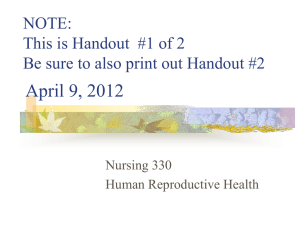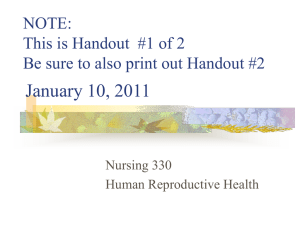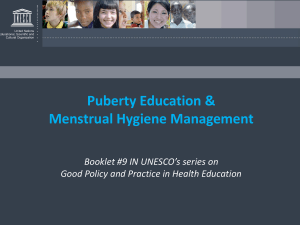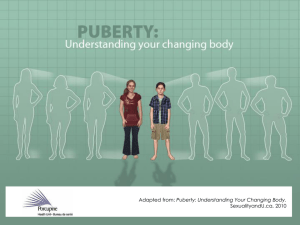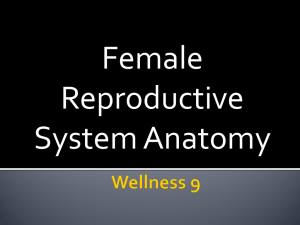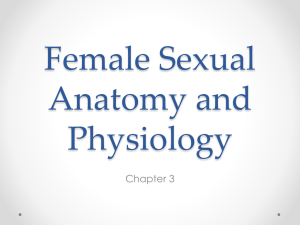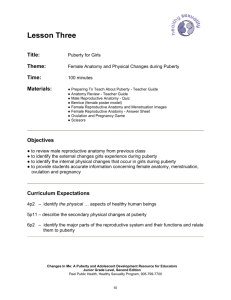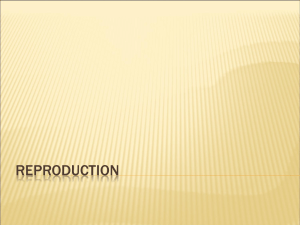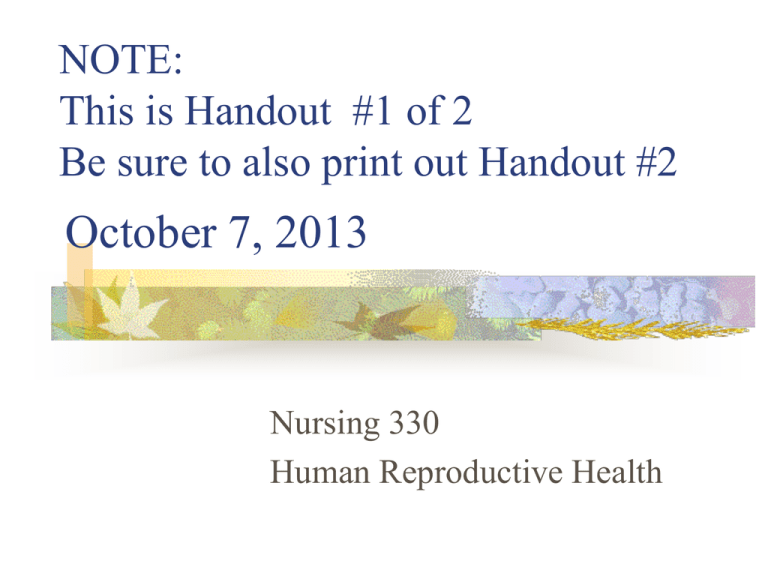
NOTE:
This is Handout #1 of 2
Be sure to also print out Handout #2
October 7, 2013
Nursing 330
Human Reproductive Health
Office Hours
Mondays, 5:30pm – 6pm
Salazar Hall, Room C162
Turnitin
Class ID: 6680500
Password: NURS330
Course Website
Syllabus
Reading Assignments
Quarter Schedule
Evaluation Methods
Lecture Notes
Print out or download on to laptop
May be taken down at anytime so it is your
responsibility to print or download before each
lecture
Important Dates
Mid-term: October 28, 2013
Essay Due: November 18, 2013
Electronically [Turnitin]
Hard Copy + Article [In Class]
Extra Credit Due: November 25, 2013
Final Exam: December 9, 2013
Puberty
Puberty
Not a synonym for adolescence
When a child transforms into an adult normally
capable of reproduction (procreation).
Refers to physical changes that occur during
adolescence
Puberty
Increase in body size
Change in shape and body composition
Rapid development
Reproductive organs
Other characteristics marking sexual maturity
Puberty
Beginning of pubertal changes occurs
between ages 11 – 16.
Varies
Pubertal changes in boys generally begin
about 2 years later than in girls.
Puberty in Girls
Average peak age: 12
Duration/Maturation: 18 mos – 6 years
Phases of Development:
1.
Breast Development
1.
Pubic Hair can precede this stage (1/3 of girls)
2.
Vagina and Uterus develop
2.
Pubic Hair (2/3 of girls)
3.
Height development/Peak in height
4.
Menarche
Puberty in Boys
Average peak age: 14
Duration/Maturation: 2 yrs. – 5 yrs.
Phases of Development:
1.
Testes and scrotum
2.
Pubic Hair
3.
Penis Growth
4.
Enlargement of:
1.
Seminal Vesicles, Prostate, Bulbourethral Glands
5.
Auxillary (Armpit) Hair
6.
Voice Deepening
Puberty (cont)
Other
Sebaceous and sweat glands
Enlargement of pores
Breast changes
Height spurt
Physical occurrences from puberty
Growth Spurt
The primary sex characteristics develop
The secondary sex characteristics develop
Growth Spurt
1. Limbs
2. Body’s trunk
3. Shoulders and chest
Bones become harder and more dense
Muscle and fat contribute to an adolescent
increase in weight
Body Composition
Girls
Develop Breast
Acquire Hips
Higher fat to muscle
ratio
Boys
Wider shoulders
More muscular neck
Lose fat during
adolescence
Primary Sex Characteristics
Differences in male and female anatomy which
are present at birth
–ovaries and testes
Defined as the change necessary to prepare girls’
and boys’ bodies to produce children
Marker events
Girls
Boys
Menarche
Spermarche
As the primary sex organs mature, the secondary
sex characteristics distinguish males from females
Secondary Sex Characteristics
Defined as changes that make boys and
girls look like mature men and women
Girls
-Breast Development
-Body fat
-Body Odor
-Body Hair
Boys
-Voice Deepens
-Shoulders broaden
-Body Odor
-Body Hair
Secular Trend
Tendency for children to become
progressively larger at all ages
Causes
Better nutrition
Lessening of disease
Hormones
Estrogen
Responsible for many changes that occur during
puberty.
Cause the breasts, uterus, and vagina to mature and
the body to take feminine proportions
Contribute to regulation of the menstrual cycle
Testosterone
Responsible for changes of male puberty
Leads to muscle growth, body and facial hair, and
other male sex characteristics
Contributes to gains in body size
Sexual Anatomy &
Physiology
Seven Essential Features of Human
Reproduction
Female Sex Organs:
Female gonads are the ovaries
All embryos appear as female at first.
Genetic and hormonal signals trigger the
development of male organs in those
embryos destined to be male.
Sex organs serve a reproductive purpose,
but they perform other functions also:
giving pleasure, attracting sex partners, and
bonding in relationships.
Vulva
The external female genitals are known
collectively as the vulva. It includes:
Mons pubis
Clitoris
Clitoral Hood (or Prepuce)
Labia Majora
Labia Minora
Urethral Opening
Anus
Female Genital Mutilation (FGM)
aka Female Circumcision
What is it?
Types
Areas where it is practiced
Consequences
Types of FGM
Type I
excision of the prepuce, with or without
excision of part or all of the clitoris
Type II
excision of the clitoris with partial or total
excision of the labia minora
Types of FGM (cont)
Type III
Aka infibulation; the most extreme
excision of part or all of the external genitalia and
stitching/narrowing of the vaginal opening
Type IV
pricking, piercing or incising of the clitoris and/or
labia; stretching of the clitoris and/or labia;
cauterization by burning of the clitoris and
surrounding tissue
Internal Organs
The internal female sexual structures and
reproductive organs include:
Vagina
Uterus
Cervix
Ovaries
Fallopian tubes
Female Sexual Physiology
During puberty hormones trigger the
completion of oogenesis, the production of
oocytes, commonly called eggs or ova.
Follicles
Sac in which eggs are carried. Found inside
the ovaries.
Female Sexual Physiology
At birth
150,000 - 500,000 follicles.
each containing an immature ova (egg)
By beginning of reproductive life
Diminishes to 34,000 follicles
During active childbearing years (ages 13 – 50)
300 - 400.follicles undergo maturation
The Menstrual Cycle
Follicular (Proliferative) phase
Luteal (Secretory) phase
aka premenstrual phase
Days 1 through 6
Beginning of menstrual flow to end of blood flow
Days 7 – 13 endometrium thickens
Days 15 to 28
The endometrium thickens to prepare the egg for
implantation
These two phases are separated by:
Ovulation
Day 14
Ovulation
The process in the menstrual cycle by which a
mature ovarian follicle ruptures and releases an
ovum (also known as an egg or an oocyte)
The released egg, unless fertilized, only lasts 12
to 24 hours.
Menstrual Cycle
Order of the Menstrual Cycle:
Menstrual → Proliferative → Secretory
The menstrual cycle is divided into 3 phases.
1. Menstruation
2. Proliferative Phase: Endometrial tissue builds up
during this phase
3. Secretory Phase: Produces nutrients to sustain an
embryo
Menstrual Phases
Typical No. of Days
Hormonal Actions
Follicular (Proliferative)
Phase
Cycle Days 1 through 6
Beginning of menstruation to end
of blood flow
Estrogen and progesterone start
out at their lowest levels
FSH levels rise to stimulate
maturity of follicles. Ovaries start
producing estrogen and levels
rise, while progesterone levels
remain low.
Cycle Days 7 -13: The
endometrium (the inner lining of
the uterus) thickens to prepare for
the egg implantation
Ovulation
Cycle Day 14
Surge in LH. Largest follicle
bursts and releases egg into
fallopian
Luteal (Secretory)
Phase
Cycle Days 15 – 28
Depends on whether fertilization
occurs or not.
Corpus Luteum
A mound of yellow tissue
Develops as a result of the ruptured follicle
During pregnancy, it serves to produce
estrogen and progesterone
If fertilization occurs,
Fertilized egg is implanted in the wall of the
uterus. Corpus luteum continues to produce
progesterone for several months and will
remain in ovary until the end of pregnancy.
If fertilization does NOT occur:
Corpus luteum becomes smaller.
Progesterone levels drop. Uterine lining
sloughs off and menstruation begins.
Hormones
Hormones are chemical substances that
serve as messengers, traveling through the
bloodstream.
Hormones
Pituitary Hormones
Luteinizing Hormone (LH)
Follicle Stimulating Hormone (FSH)
Ovarian Hormones (aka sex hormones)
Estrogen
Progesterone
The Path of the Egg
Reaches uterus about 2-4 days after ovulation
Moves slowly toward uterus
Swept into fallopian tube
Released from follicle
The egg, unless fertilized, only survives 12-24 hours.
PMS
Premenstrual syndrome (PMS) is a group
of symptoms related to the menstrual cycle
PMS
Physical and emotional disorder
Caused by hormonal changes
Widely recognized as a medical condition
85% of menstruating women have at least
one symptom
5-10% debilitating symptoms
Symptoms present two weeks before
menstruation
Remedies:
Dietary Recommendations
Low fat
High fiber
3 meals a day and 3 snacks containing starchy
foods
Drink plenty of water
Avoid caffeine
Low salt
High calcium
Menstrual Conditions
Two types
Amenorrhea
Dysmenorrhea
Amenorrhea
Primary
failure to start having a period by the age of 16
Secondary
temporary or permanent ending of periods in a woman who
has menstruated normally in the past
Menstrual Disorders (Cont)
Dysmenorrhea - Painful menstrual periods (aka
cramps)
Primary
no physical abnormality and usually begins within
three years after you begin menstruating
Secondary
involves an underlying physical cause, such as
endometriosis or uterine fibroids

